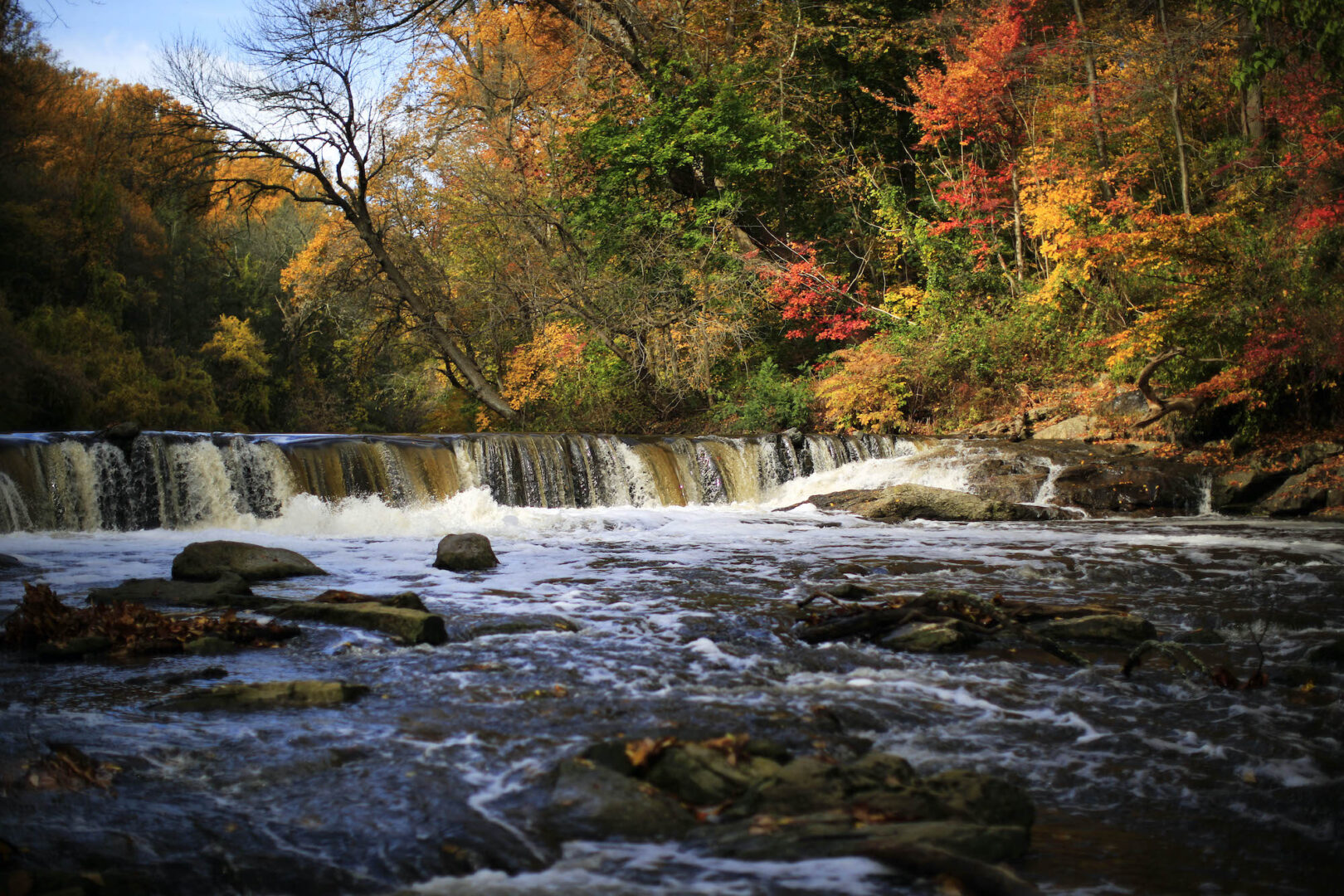
Water flows down the Wissahickon Creek in view of the Autumn foliage Thursday, Oct. 29, 2015, in Philadelphia. (AP Photo/Matt Rourke)
Matt Rourke / AP Photo


Water flows down the Wissahickon Creek in view of the Autumn foliage Thursday, Oct. 29, 2015, in Philadelphia. (AP Photo/Matt Rourke)
Matt Rourke / AP Photo

Matt Rourke / AP Photo
Water flows down the Wissahickon Creek in view of the Autumn foliage Thursday, Oct. 29, 2015, in Philadelphia. (AP Photo/Matt Rourke)
Several rivers and creeks around Philadelphia contain the toxic class of chemical PFAS — from the Schuylkill River, to the Wissahickon, Neshaminy, and Valley creeks — according to the U.S. Geological Survey.
PFAS can remain in the bloodstream for years, and the chemicals are linked to serious health problems, including some cancers, thyroid disease, ulcerative colitis, and developmental delays in children. That has led to numerous lawsuits against companies that make the products, such as DuPont and its successor companies, and 3M.
The USGS tested 61 Pennsylvania rivers and streams for PFAS, and found 76% contained one or more types of the chemical. The highest concentrations of PFAS were found in high-population areas, including Philadelphia and Pittsburgh.
The study was a collaboration between the Pennsylvania Department of Environmental Protection and the Susquehanna River Basin Commission.
Known as “forever chemicals,” PFAS are commonly used in products from nonstick cookware to firefighting foam, and can remain in the environment for years. So, experts say detecting PFAS in waterways is not surprising.
However, the USGS report determines the sources of contamination in each waterway. Researchers say that could guide PFAS regulations statewide, and help water providers determine whether they need to monitor PFAS in surface water.
“The findings can be used by industry permitted facilities and government regulatory agencies to determine the best practices that mitigate surface water contamination and potential exposures to humans, as well as aquatic species residing in the surface waters,” said Sara Breitmeyer, a chemist with the USGS.
PFAS levels were the highest in Valley Creek near Valley Forge and in the Neshaminy Creek near Langhorne.
The chemicals also were detected in the Schuylkill River in Philadelphia and Pottstown, the Wissahickon Creek in Philadelphia and Fort Washington, and the Brandywine Creek in Chadds Ford.
These waterways are sources of drinking water for residents in Philadelphia, the surrounding counties, and Wilmington, Del. However, the results only represent raw surface water, and not the amount of PFAS that comes out of taps. Several water providers already treat PFAS down to low levels before distributing it to customers — though 45% of tap water in the U.S. contains some level of PFAS, according to the USGS.
Some of the findings weren’t surprising, said researcher Joe Duris, a water quality specialist with the USGS Pennsylvania Water Science Center. For example, Neshaminy Creek is located near a decommissioned military base in Horsham known for using firefighting foam, which contaminated nearby drinking water supplies. The creek also is under a fishing consumption advisory.
However, Duris said he was surprised to learn of the high levels of PFAS in Valley Creek. The contamination there is caused by wastewater treatment plants and electronics manufacturing facilities, the researchers found. These industries contributed to the most PFAS contamination throughout the state, according to the study.
“It’s kind of an under-recognized source right now in the literature. But electronics manufacturing, chip manufacturing, those processes do use PFAS,” Duris said.
The Environmental Protection Agency set a health advisory for PFAS in drinking water at almost zero parts per trillion. However, there are no enforceable federal regulations for the contaminants. That has prompted some states, including New Jersey, and most recently, Pennsylvania, to take it upon themselves to implement what are known as maximum contaminant levels, or MCLs.
In March, the EPA proposed federal standards that would restrict the amount of PFAS in public drinking water nationwide. The proposed MCLs are much stricter than those set in New Jersey and Pennsylvania.
Several of the rivers and streams the USGS studied contained PFAS above the EPA’s proposed standards for drinking water. However, the study did not evaluate the treated tap water sourced from these contaminated waterways.
The USGS is also researching the impacts of PFAS on wildlife, as well as PFAS levels in municipal water treatment plant discharges into waterways.
StateImpact Pennsylvania is a collaboration among WITF, WHYY, and the Allegheny Front. Reporters Reid Frazier, Rachel McDevitt and Susan Phillips cover the commonwealth’s energy economy. Read their reports on this site, and hear them on public radio stations across Pennsylvania.
(listed by story count)
StateImpact Pennsylvania is a collaboration among WITF, WHYY, and the Allegheny Front. Reporters Reid Frazier, Rachel McDevitt and Susan Phillips cover the commonwealth’s energy economy. Read their reports on this site, and hear them on public radio stations across Pennsylvania.
Climate Solutions, a collaboration of news organizations, educational institutions and a theater company, uses engagement, education and storytelling to help central Pennsylvanians toward climate change literacy, resilience and adaptation. Our work will amplify how people are finding solutions to the challenges presented by a warming world.